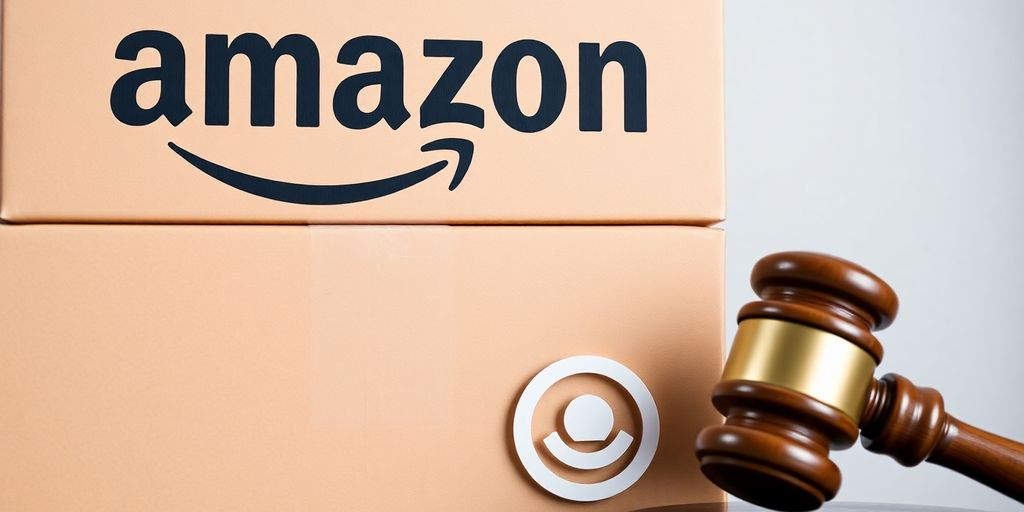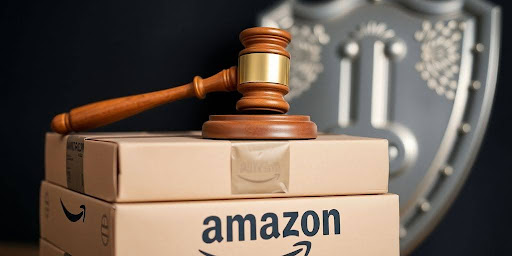
So, what exactly is an Amazon Copyright infringement report? Well, it’s a formal complaint you send to Amazon when you believe someone is selling something that violates your intellectual property rights. This could be anything from using your copyrighted images to selling knock-off products that copy your trademarked brand name. You’re telling Amazon, “Hey, this seller is doing something they shouldn’t be doing, and it’s hurting my business!”
Okay, so you’ve figured out that someone is infringing on your rights. Now what? You gotta find the right tool on Amazon to report it. It can be a little tricky to find, but look for something like “Report Infringement” or “Report a Violation.” Amazon wants you to use their specific forms, so you’ll need to dig around a bit. Once you find it, be prepared to fill out a substantial amount of information. It’s not the most fun process, but it’s necessary to protect your stuff.
Alright, you’ve found the report form, now comes the fun part: filling it out. Amazon wants details, and they want proof. You’ll need to provide a clear description of what’s being infringed upon – is it a logo, a product design, or copyrighted text? You’ll also need to point out exactly where on Amazon the infringement is happening, usually with ASINs (Amazon Standard Identification Numbers) or product page URLs. And most importantly, you’ll need to provide evidence that you own the rights you’re claiming. Think of it like building a case; the more solid evidence you have, the better.
So, you think someone on Amazon is using your copyrighted material? It’s a pretty common problem. You’ve got to be specific when you report it. Don’t just say “they stole my stuff.” You need to point out exactly what’s being infringed upon – is it your product photos, the text from your product description, or something else? The more details you give, the better. Make sure you understand the amazon copyright infringement policy before you start.
Evidence is key. Amazon won’t take action based on just your word. You need to show them proof that you own the copyright and that the other seller is using it without your permission. This could include things like a copyright registration certificate, original design files, or even just dated photos that prove you created the work first. The stronger your evidence, the more likely Amazon is to take your claim seriously. It’s also important to understand that by providing an image for a product listing page, you are allowing Amazon to use that image.
To really make your case strong, think about what makes your product unique and how the infringing product is copying it. Is it the overall design, a specific feature, or the way you’ve presented it? Highlighting these similarities can help Amazon understand the extent of the infringement. Also, keep in mind that you can file an amazon copyright infringement appeal if you disagree with Amazon’s decision.

Okay, so you’re selling on Amazon, and you’re worried about someone ripping off your designs or using your brand name without permission? That’s where Amazon Brand Registry comes in. It’s Amazon’s way of saying, “Hey, we’ll help you protect your stuff.” The big benefit is that you get access to a bunch of tools that make it easier to find and report potential infringements. Think of it as having a security system for your brand on Amazon. It’s not perfect, but it’s way better than nothing. Plus, it gives you more control over your product listings and brand presence.
Once you’re enrolled in Brand Registry, you get access to the RAV tool – that’s short for Report a Violation. It’s pretty straightforward. You can use it to report suspected violations of your intellectual property rights, like copyright or trademark infringements. You just fill out a form, provide some evidence, and Amazon takes it from there. It’s way easier than trying to navigate the regular infringement reporting process. And, honestly, it feels good to have a direct line to Amazon when you see someone trying to steal your hard work. It’s like having a special bat-phone for intellectual property issues.
Brand Registry isn’t just about reporting stuff after it happens. It also gives you access to resources that can help you proactively protect your brand. For example, Amazon has programs that use product serialization to make sure only real products get shipped to customers. They also have internal tools that constantly scan the marketplace for potential problems. It’s like having a team of detectives working to protect your brand around the clock. It’s not a guarantee that you’ll never have any issues, but it gives you a leg up in the fight against copyright infringement and other bad stuff. Plus, it shows Amazon that you’re serious about protecting your brand, which can only help in the long run.
Okay, so you’ve filed an infringement report. What happens next? Amazon usually tries to take a look at these reports pretty quickly. You can often expect to hear something back from them within a few days. However, don’t confuse that initial acknowledgment with a full resolution. It’s just the start of the process. They’ll let you know they received it, but the real work is just beginning.
How long will the whole thing take to resolve? That’s a different story. A bunch of things can affect the speed. The complexity of the case is a big one. If it’s a straightforward copyright violation, things might move faster. But if it’s a complicated situation with lots of back-and-forth, expect it to drag on. Also, how fast you and the other party respond to Amazon’s requests matters. Amazon’s internal processes and workload also play a role. They don’t give a definite timeframe, so patience is key.
After you send in your report, Amazon will review the information you provided. They might ask you for more details or evidence. They’ll also likely reach out to the other seller to get their side of the story. Amazon will then weigh everything and make a decision. You’ll get notified of the outcome, whether they take action against the other seller or not. Just be prepared for a potentially lengthy process, and make sure you keep all your documentation organized. It’s also a good idea to understand Amazon IP Complaint procedures.

It’s super frustrating when you put in the effort to report something, only to have Amazon reject it. Don’t give up immediately, though. There are a few things you can do to try and get a different outcome.
First things first, really dig into the reason Amazon gave for rejecting your report. They usually provide some kind of explanation, even if it’s vague. Understanding their reasoning is key to figuring out what went wrong. Did you not provide enough evidence? Was your claim unclear? Did you fail to specify the nature of infringement adequately? Knowing the ‘why’ helps you fix it.
Okay, so you know why it was rejected. Now what? Revise your report based on the feedback. If they said you needed more evidence, gather more evidence. If your claim was unclear, rewrite it to be crystal clear. Make sure you’re using the Amazon Report Infringement form. Double-check everything before you hit submit again. It can be helpful to have a fresh pair of eyes look over it, too.
If you’ve resubmitted your report a couple of times and it’s still getting rejected, it might be time to call in the pros. Copyright law can be tricky, and sometimes you need an expert to help you navigate the situation. An Amazon seller attorney can assess your case, advise you on the best course of action, and even represent you in communications with Amazon. It’s an investment, but it could be worth it if you’re dealing with a serious infringement issue.
Making a false copyright claim on Amazon isn’t something to take lightly. Amazon has rules against it, and they will enforce them. If you file a report that turns out to be misleading or just plain wrong, you could face some serious consequences. It’s like crying wolf; do it too often, and no one will believe you when you have a real problem.
One of the most immediate risks is having your product listings taken down. Even worse, Amazon could suspend your entire seller account. Think about it: your livelihood depends on being able to sell on Amazon, so losing that ability would be a major blow. It’s a big deal, and Amazon doesn’t hesitate to take action against sellers who abuse the system. It’s like getting kicked out of the store for bad behavior.
Beyond Amazon’s penalties, you could also face legal trouble. If you falsely accuse someone of copyright infringement, they might sue you for damages. A false claim could be considered defamation, which has real legal consequences. You could end up paying a lot of money in damages and legal fees. It’s not worth the risk. So, before you file a report, make sure you have solid evidence and that you’re not just trying to bully a competitor.
Sometimes, dealing with copyright stuff on Amazon gets tricky. You might hit a wall, or the situation could be more complex than you first thought. That’s when it’s a good idea to get a lawyer involved. It’s like when you try to fix something yourself, but then realize you need a professional.
So, when should you call a lawyer? If you’re dealing with repeated Copyright Infringement issues or if Amazon suspends your account because of copyright claims, it’s probably time. If you’re losing sleep over it, a lawyer can help. They know the ins and outs of Amazon’s rules and can give you solid advice.
Copyright law can be a real headache. Figuring out who owns what and what’s actually infringement can be super confusing. A lawyer who knows about Amazon and copyright law can sort through all that mess. They can look at your specific situation and tell you what your options are. It’s like having a guide through a jungle of legal jargon.
Even with Amazon’s processes, sometimes things just don’t get resolved. Maybe the other seller isn’t cooperating, or Amazon’s decision doesn’t seem fair. A lawyer can explore other ways to solve the problem. This could mean sending a cease and desist letter or even taking legal action. It’s about having someone on your side who knows how to fight for your rights.
When you’re facing tough legal problems, getting help from a lawyer is super important. They know the rules and can guide you through everything. Don’t try to figure it all out alone! If you need someone to talk to about your situation, we offer a free chat to help you understand your options. Just click here to get started.
An Amazon infringement report is a formal complaint you send to Amazon. It’s for when you believe someone else on their site is using your original work, like your designs or writings, without your permission. This is often called a violation of your intellectual property rights.
To tell Amazon about a violation, go to their ‘Report Infringement’ tool online. You’ll need to fill out some forms with lots of details about what happened. Make sure to include proof to back up what you’re saying.
Yes, you can report when someone copies your creative work without permission on Amazon. Use the special tool they have for copyright problems. You’ll need to provide all your documents and proof of your original work.
The time it takes for Amazon to get back to you can change, but they usually try to look at violation reports within a few days. If they need more information, they might contact you to ask for it.
If your report isn’t accepted, read Amazon’s feedback carefully. Then, make any needed changes to your documents. You can send your report again with more proof or clearer information if needed.
Amazon might take down your product or even stop you from selling if you falsely claim someone copied your work. The other person might also decide to sue you for damages. Making a false claim can have serious legal problems.